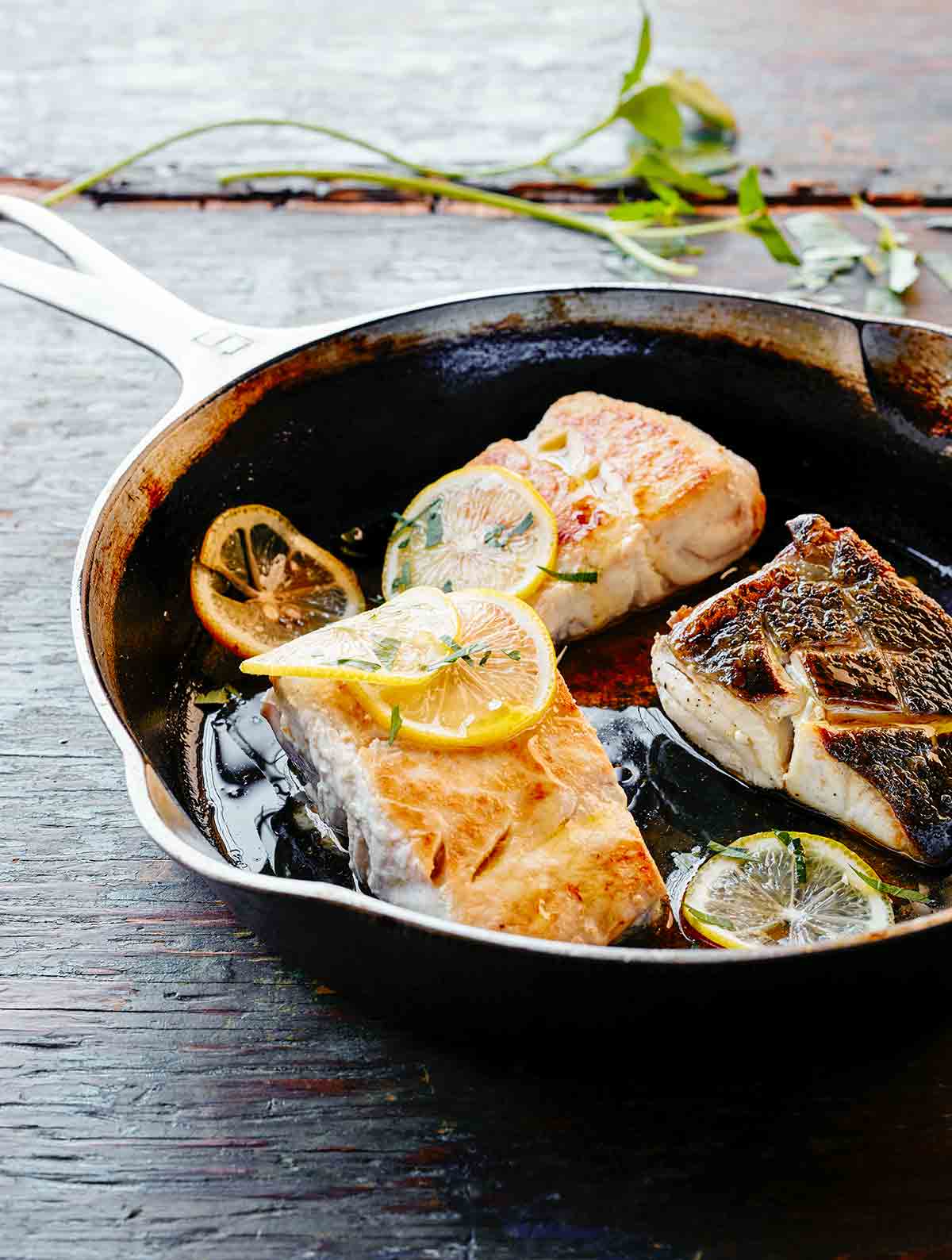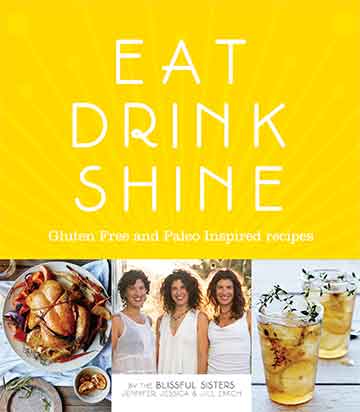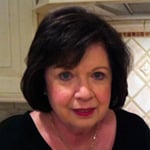
This easy pan-fried fish recipe is as easy as it gets. We understand that it’s easy to be timid about cooking seafood, but this technique works perfectly to put a sear and a crisp skin on any fish fillet.–Renee Schettler Rossi
Pan Fried Fish FAQs
You can, but be sure to thaw it completely and try to get as much moisture out of your fillets as possible. Excess water or ice crystals in the pan can cause your fish to boil or steam in some areas or cook unevenly, and you may not achieve the desired crisp-skin effect. Thawed and patted dry properly, you should be able to proceed with the recipe as directed below.
First, the don’ts: Don’t thaw fish at room temperature, it’s just not a safe option due to potential bacteria growth as the fish thaws. Also, don’t microwave. Because fish fillets typically vary in thickness from edges to center, microwaving can cook your edges and alter the overall texture.
Here’s what to do: If you are planning ahead, remove the fish from the freezer and put it in a bowl (in its original package) in the fridge in the morning and by the time you’re ready to cook dinner, the fish should be ready to go. If you didn’t plan ahead and need to thaw in a hurry, put your frozen fish – again, still in its original packaging – in a large bowl and cover it with room temperature-ish (but not warm) water. If your water is too cold, your fish won’t thaw quickly and if it’s too warm, you could have texture and bacteria issues again. Change out the coolish water every twenty minutes or so. Once your fish is bendy and soft, you should be ready to open it up, dry it completely, and get dinner going.
At the grocery store or market, fresh fish is typically stored on ice. Look at the ice to ensure it’s clean, with no stains or greying. If your fish is already packaged, ensure it’s dry and clean in there. Give it a sniff – does it have a strong, fishy, off-putting odor? Your fish should smell fresh, briny, and sweet, not musty, bitter, or fishy. Ask the fishmonger or butcher if the fish has been thawed from frozen. While that shouldn’t affect the texture, you should never refreeze seafood after it’s been thawed. If it’s previously frozen, plan to eat it the day you buy it. Poke it (if you can). The flesh should be firm. It should look moist; any whitish filmy substance on it could mean it’s drying out. Also, ensure that the coloring is even, on white-fleshed fish, there should be no darkened areas.

Pan Fried Fish
Ingredients
- Four to six (5-ounce) fish fillets, skin on and bones out (such as halibut, snapper, flounder, salmon, or trout)
- 2 tablespoons unsalted butter, ghee, coconut oil, or extra-virgin olive oil
- Sea salt, to taste
- 1 lemon, thinly sliced, for serving
- Chopped fresh herbs, for serving (optional)
- Homemade Tartar Sauce, (optional)
Instructions
- Using the tip of a sharp knife, score the skin side of each fillet with shallow incisions, being careful to cut through the skin but not through the fish. This will help prevent the skin from curling at the edges. Pat the fish completely dry.
- Heat a large cast-iron skillet or sauté pan over medium to medium-high heat until hot but not smoking. Add the fat to the skillet and let it warm.
- Salt both sides of the fish. Add the fish to the pan, skin side down, and let it cook undisturbed until it’s cooked about 2/3 of the way through. The exact timing will depend on the thickness of the fish fillet but figure about 3 minutes for thin fillets such as flounder and about 7 minutes for thick fillets such as salmon. You can baste the fish with the fat as it is cooking if you want but do not move the fish or else the skin will not crisp. You can tell how done the fish is by looking at the side of the fillet and watching where the fish is opaque.
- Once the fish is cooked most of the way through and the skin is golden brown and crisp, flip the fish. (If you think the fish is ready to be flipped but try to coax the skin from the skillet with a slender metal spatula and the skin sticks to the pan, give it another 30 seconds or so and try it again.) After you flip the fish so it's skin side up, cook just until the fillet is cooked through. This should only take a minute or two for thin fillets and about 4 minutes for thick fillets. Keep an eye on the fish as you cook it, as overcooked fish loses its delicate flavor and can become “fishy” tasting and dry.
- Arrange the fish on plates and garnish with lemon slices and herbs, if desired. (These seemingly unnecessary garnishes go a long way in imparting flavor to the fish. They also come in handy to cover any blemishes that may have occurred when you stuck the tip of a knife into the fish to check for doneness or where the skin stuck to the skillet.)

Nutrition
Nutrition information is automatically calculated, so should only be used as an approximation.
Recipe Testers’ Reviews
This pan fried fish recipe is one of the easiest methods for cooking fish, and you’ll get some nice flavor from a crisp skin. I used a combination of olive oil and unsalted butter to cook my halibut fillets. Scoring the skin will definitely prevent the skin from curling up. Halibut fillets are fairly thick and will take about 4 minutes on the skin side and 3 to 4 minutes more on the flesh side. When the fillet has cooked on the skin side for a few minutes, it’s best to try to lift up the fish with a spatula. If it releases easily, then you can turn the fish. If not, try again in about 30 seconds. Don’t force it or you may end up with a crumbled fish fillet. For best results, your pan should be well-heated and the fat should be hot before the fish is added to the pan. If you are not sure that your fish is cooked, you can check its internal temperature with an instant-read thermometer—140°F is the correct temperature for properly cooked fish. You will get an additional 5 degrees from carryover cooking after the fish is removed from the pan. The fish should be opaque and flake easily with a fork. Lemon slices are all you need to garnish. Serving the fish with the Homemade Tartar Sauce on the site is also a nice enhancement to this dish.
The fish was delish! I served it as an appetizer to guests at a dinner party, and we all agreed that it was a winner. The only reason I wouldn’t give this a “10” was because of the mess. When I added the fish to the heated fat, it splattered all over the stove and countertop. With my guests ready to be seated, I didn’t have time to clean it up and faced it afterward with all the dishes. I would make sure to pat the fish thoroughly dry before adding it to the hot fat. That said, I used 4- to 6-ounce salmon fillets and cooked them in coconut oil. I scored the skin of each fillet, and the skin didn’t curl. The fillets were easy to turn and didn’t stick to the bottom of the cast-iron skillet. My 1 1/4-inch-thick fillets took 6 to 7 minutes to cook 2/3 of the way through, then another 4 minutes after they were turned. The recipe calls for flipping the fish. I would suggest turning it carefully, as flipping it just resulted in more splatter. My fillets might have taken longer to cook than the recipe stated because they were still cold from the refrigerator. I did baste the fish with the hot oil as it was cooking. It was somewhat difficult to tell if the fish was done properly, so I had to check it with a fork a couple times to see if it flaked, but this was easily covered up with the lemon slices. Everyone loved the fish, but I noticed that no one touched the skin. I served it alongside a sauce of mayonnaise, balsamic vinegar, and garlic. I would highly recommend this recipe with a caveat—don’t make it when you’re trying to do other things at the same time. This needs your undivided attention.
This pan seared fish came out well—very moist and delicious. The lemon slices for serving seemed like such a simple addition, but the citrus enhanced the flavor of the fish in a delicate way. I used four 5-ounce rainbow trout fillets, each about 1/2 inch thick. Because of the relative thinness of the fillets, they cooked fairly quickly. I cooked them for 3 minutes on the first side and then flipped them. The skin of one fillet curled a bit during this step. They cooked 2 minutes on the other side, and one more curled. Because the skin was pretty thin, it was tricky to score only that and not cut into the flesh, so that might be the reason for the curling. The skin was not especially crisp. I think I would have had better success on the crispness front had I used a different type of fish and/or thicker fillets and a cast-iron skillet rather than a sauté pan. While my sauté pan was hot, a cast-iron skillet could have gone higher and held the heat better. And using something like salmon fillets, which are thicker, would probably have been more effective with this technique. Even so, these were good. Getting the skin to crisp would be a bonus.
Loving fish as I do, I jumped at the opportunity to test this pan fried fish recipe. I used a couple gorgeous fresh South Carolina flounder from my local fishmonger. The final taste was spectacular. Juicy and perfectly cooked. I cut each flounder into 3 slices. When scoring the skin, make sure to use a very sharp knife and be careful not to cut through to the fish. The skin did not curl up at all. Time-wise, the first side took about 7 minutes and the other side about 5 minutes. Not bad for a weeknight dinner. The fish did stick more than I expected and lost its skin. I’m not sure if this was due to ghee, as it was the first time I tried using ghee to pan-fry fish. I wonder if cooking it in the oven—first warming the cast-iron, then adding the fish, skin side down, and placing it in the oven at 450°—would be best, as this way, we wouldn’t have to turn the fish, and the fillets would cook through and still have a nice crisp skin.













